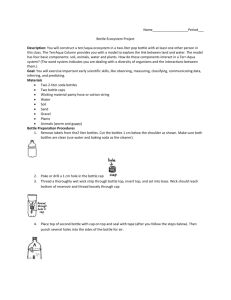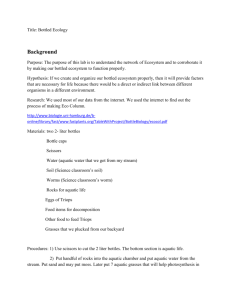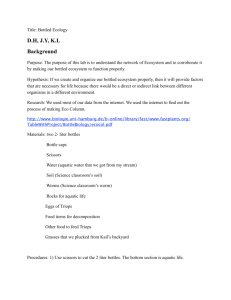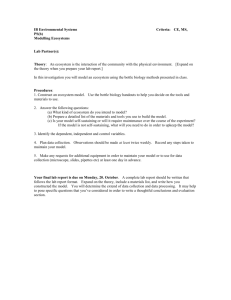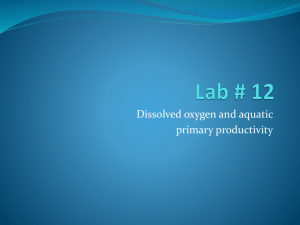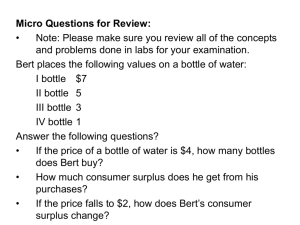File - Paxson Science
advertisement
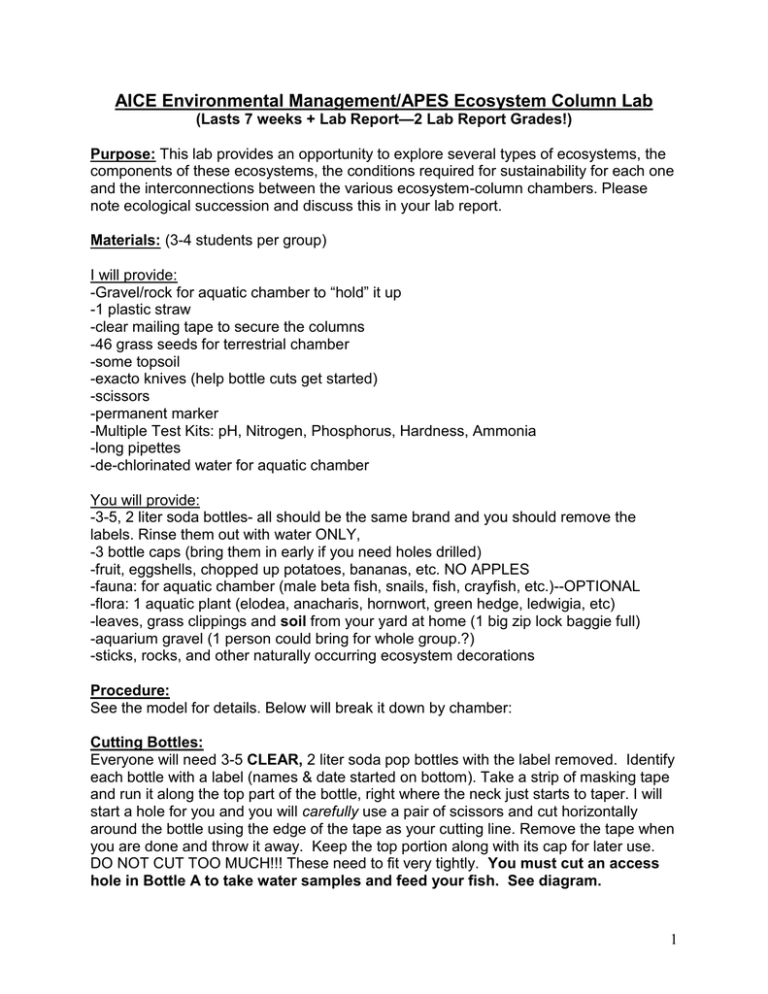
AICE Environmental Management/APES Ecosystem Column Lab (Lasts 7 weeks + Lab Report—2 Lab Report Grades!) Purpose: This lab provides an opportunity to explore several types of ecosystems, the components of these ecosystems, the conditions required for sustainability for each one and the interconnections between the various ecosystem-column chambers. Please note ecological succession and discuss this in your lab report. Materials: (3-4 students per group) I will provide: -Gravel/rock for aquatic chamber to “hold” it up -1 plastic straw -clear mailing tape to secure the columns -46 grass seeds for terrestrial chamber -some topsoil -exacto knives (help bottle cuts get started) -scissors -permanent marker -Multiple Test Kits: pH, Nitrogen, Phosphorus, Hardness, Ammonia -long pipettes -de-chlorinated water for aquatic chamber You will provide: -3-5, 2 liter soda bottles- all should be the same brand and you should remove the labels. Rinse them out with water ONLY, -3 bottle caps (bring them in early if you need holes drilled) -fruit, eggshells, chopped up potatoes, bananas, etc. NO APPLES -fauna: for aquatic chamber (male beta fish, snails, fish, crayfish, etc.)--OPTIONAL -flora: 1 aquatic plant (elodea, anacharis, hornwort, green hedge, ledwigia, etc) -leaves, grass clippings and soil from your yard at home (1 big zip lock baggie full) -aquarium gravel (1 person could bring for whole group.?) -sticks, rocks, and other naturally occurring ecosystem decorations Procedure: See the model for details. Below will break it down by chamber: Cutting Bottles: Everyone will need 3-5 CLEAR, 2 liter soda pop bottles with the label removed. Identify each bottle with a label (names & date started on bottom). Take a strip of masking tape and run it along the top part of the bottle, right where the neck just starts to taper. I will start a hole for you and you will carefully use a pair of scissors and cut horizontally around the bottle using the edge of the tape as your cutting line. Remove the tape when you are done and throw it away. Keep the top portion along with its cap for later use. DO NOT CUT TOO MUCH!!! These need to fit very tightly. You must cut an access hole in Bottle A to take water samples and feed your fish. See diagram. 1 Bottle A - Aquatic Habitat-This houses the aquatic ecosystem. 1. Add topsoil and regular soil together. Mix to provide the sediment. Fill 2-3 cmpack tight on bottom with metal blades, no glass stirring rods. 2. Put gravel on top to provide the bedrock-1-2 cm 3. Add water that has been declorinated, about 1 cm below the cap of the lower deep funnel—see small hole for feeding—make it below this opening. 4. Add “boulders” or sunken logs…things you would normally find on a pond bottom. 5. Add your aquatic plants (roots in bottom sediment, push into ground) note some float…it depends on what you buy. 6. Add animals after the sediment settles. (male betas-wait till day 2). 7. Add fish food. Bottle B - empty Bottle C - Compost Habitat: 1. Add fine grained aquarium gravel, 1-2 cm. 2. Add topsoil mix and your yard’s soil and mix together - 2-3 cm over gravel. 3. Add “leaf litter” (provides compost habitat)-leaves, grass clippings, twigs-1 cm below the cap of the upper deep funnel. 4. Add minced fruits (no apples), egg shells, potatoes, roots, stems. Best at sides for better observation. BE SPARING WITH THE POTENTIALLY STINKY STUFF!!! 5. Add earwigs, bugs, millipedes, other natural inhabitants of leaf litter (may already be in there). 6. Establish a water connection between aquatic and compost habitats by slowing pouring water down the side of the terrarium until it drips from the bottle cap into the aquarium. This is essential to ensure wicking action. Bottle D - Terrestrial Habitat: topsoil and ~50 grass seeds: 1. Add fine-grained aquarium gravel, 1-2 cm. 2. Add equal amounts of topsoil and leaf litter-mix together (provides decaying material). Moisten lightly. Add 6-8cm over the gravel. 3. Add ~50 grass seeds. 4. Add other terrestrial plants (grass seed, other). Arrange “dead trees” if desired. 5. OPTIONAL: Add animals (burrow in soil-worms). 6. Food for animals as needed. -This chamber aerates (straw) Bottle E - empty Bottle F-empty-precipitation funnel, cap simulates rainfall Monitoring: -This lab will run for 7 weeks. -Testing will be done once a week (Fridays). See Data Sheet 2 -You will also write a formal lab report (see lab report guidelines) -These will be two different grades—observations will be a major part of your notebook grade this nine weeks. Ecocolumn Observations Part of being a great scientist is making great observations. It can be tedious and timeconsuming to constantly observe and record observations during experimentation times - especially if the experiment continues over a long period of time (most do). You and your partners must observe your ecocolumn over a period of 7 weeks. You need to record quantitative data just ONCE a week, but it should be observed qualitatively every day, even if just in passing as you walk in the classroom. Quantitative measurements will have a number and a unit and should be recorded using the format on your data sheet in your lab notebook. For example: temperature of water, pH, plant growth, population changes, amount of water in column (mL), etc.. Qualitative observations include changes you notice using sense organs: odor, color, shape, slow or quick movements, etc. We will use microscopes the last 3 weeks. You team will decide how to organize data and keep track of daily changes. The Data Sheet format will only record the once a week qualitative changes. I will grade additional things, e.g., is the water clear, is the fish alive, are plants healthy? Your lab report will have the graphs, charts, and recorded observations in detail. Ecocolumn Maintenance -Provide some sunlight-full sun may not be best. -Keep the soil moist but not too saturated or too dry. A little water each week should be fine. A fine spray of water also maintains plant units well. -Algae may need to be swirled and removed if the snail (may not be present) can’t keep up with eating it. Many people have to remove it weekly. Filamentous algae can be removed with tweezers. -Once a week remove about 25% of the water and replace it with fresh water (that has been designated for you in the jugs in the back of the classroom). Use long pipettes to do this. -Remember, too little of anything is probably better than too much. Your ecosystem is small and doesn’t need huge quantities to survive and maintain its equilibrium. Please note: 1. Week 1-mostly bacteria is in the water 2. Week 4-start microscope observations-look at ecological succession 3. Week 4-protists (note bacteria, protists, what you see in the microscope) 4. Week 5-algae and paramecium appear 5. Week 7-algae increases. You might see worms—means it’s collapsing. 3 AICE EM/APES Ecosystem Column Data & Observations (7 weeks) Group Members: ____________________________________________________ Date Fauna (type, amount) Flora (cm) Dissolved Oxygen Phosphorus Nitrogen pH Qualitative Observations (week 4-8 microscopes) Date Fauna (type, amount) Flora (cm) Dissolved Oxygen Phosphorus Nitrogen pH Qualitative Observations (week 4-8 microscopes) 5 6
